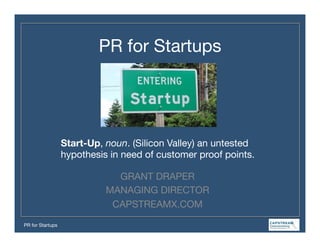Capstream x pr for startups
- 1. PR for Startups GRANT DRAPER MANAGING DIRECTOR CAPSTREAMX.COM Start-Up, noun. (Silicon Valley) an untested hypothesis in need of customer proof points. ┬Ā PR for Startups
- 2. PROBLEM/OPPORTUNITY ŌĆóŌĆ» Competitors are everywhere ŌĆóŌĆ» More noise and clutter than ever before ŌĆōŌĆ»# of marketing messages per day has risen from a few hundred in the 1970s to between three to ’¼üve thousand today ŌĆōŌĆ»Database tracking >10,000 working media in the energy, agriculture, food, water and technology sectors ŌĆóŌĆ» In 2011, 2.2 billion people had access to the Internet PR for Startups
- 3. PLAN ŌĆóŌĆ» Develop your PR plan when you set your business goals and not after a failed sales effort ŌĆóŌĆ» Make sure it includes strategy, tactics, scalability and a timeline of items for execution ŌĆóŌĆ» Great PR wonŌĆÖt ’¼üx crappy products but it will help good ones PR for Startups
- 4. AUDIENCE ŌĆóŌĆ» PR is social conversation ŌĆóŌĆ» People value and expect social context ŌĆóŌĆ» Expectation is to consume native content ŌĆóŌĆ» PR can play a valuable role at each stage of your customer funnel/hierarchy ŌĆōŌĆ»Awareness, interest, consideration, purchase and all the way through to ongoing relationship building when you ask customers to amplify your story PR for Startups
- 5. VALUE ŌĆóŌĆ» Effective PR builds business momentum by supporting opportunistic business development, awareness building, etc. ŌĆóŌĆ» Research has demonstrated executives equipped with PR expertise can increase their companyŌĆÖs enterprise value by up to 40% PR for Startups
- 6. TELLING YOUR STORY ŌĆóŌĆ» Ask yourself why would a journalist be interested in hearing from you ŌĆóŌĆ» Journalists are in the business of producing newsworthy content so ask yourself how can you help them ŌĆóŌĆ» Research shows stories with amusing, arousing or anger inducing themes more likely to be shared while inspiring and emotion evoking stories are more likely to be consumed PR for Startups
- 7. DEVELOPING YOUR STORY ŌĆóŌĆ» What are your most interesting products, customers, clients, etc. ŌĆóŌĆ» Which audience(s) would ’¼ünd your story valuable to know ŌĆóŌĆ» Startup story archetype ~ heroŌĆÖs journey ŌĆōŌĆ» What quest were you called on ŌĆōŌĆ» What huge challenges have you overcome on your unclear path forward ŌĆōŌĆ» How have demonstrated your courage, agility, stamina, ingenuity, resourcefulness, etc. PR for Startups
- 8. MECHANICS ŌĆóŌĆ» Developing your positioning, messaging and content delivery tools ŌĆōŌĆ» Positioning statement (what does your company stand for from a customer POV) ŌĆōŌĆ» Messaging (does your USP explain why youŌĆÖre worth buying versus your competitors) ŌĆōŌĆ» Media training (preparing talking points for messaging speci’¼üc to each story and content native to each platform) ŌĆōŌĆ» Dissemination (news releases, wire services, Google News, #s trending on twitter, etc.) PR for Startups
- 9. PITCHING ŌĆóŌĆ» Start with the story and determine newsworthiness ŌĆóŌĆ» Depth is more important than breadth ŌĆōŌĆ» Relationships matter ŌĆō contact the reporters you know and you read/view, etc. ŌĆōŌĆ» Read their latest tweets, re-tweets and stories ŌĆōŌĆ» Email a succinct (3-4 sentence) pitch that provides what your story offers their audience ŌĆōŌĆ» Better to use hyperlinks than attachments ŌĆōŌĆ» Best days are Tuesday, Wednesday and Sunday ŌĆōŌĆ» Follow-up with a call and if no response send a second email with additional info that will interest their audience PR for Startups
- 10. ROI ŌĆóŌĆ» What should you pay ŌĆóŌĆ» Should you go external or internal ŌĆóŌĆ» What are your requirements ŌĆōŌĆ»24/7 market coverage or support for an upcoming sales campaign ŌĆóŌĆ» PR produces the greatest ROI when its being effectively used to support focused and opportunistic business development activities and awareness building PR for Startups










